
Author: Dipanwita Ray
The article, '72 different types of sarees from the different states of India' is published in two parts. In this part (Part I), 27 different types of sarees from the northern, central, and western regions of India are covered. The second part covers 45 different types of sarees.
Introduction
Be it a festive Dussehra, Diwali, or any ceremonial occasion, one simply cannot deny the sheer elegance that this attire brings to the wearer. A Sari (alternately spelled Saree or Shari) is one of the world’s oldest attire of un-stitched clothing/garment. The origins can be traced back to the Indus Valley Civilisation, and the first mention of saris is in the Rig Veda, dating to 3,000 B.C. The word sari is derived from the Sanskrit word ‘sati’, which means the strip of cloth. In Prakrit, the word evolved to sadi and was later anglicised into the sari.
The parts of a saree are usually referred to as:
- Border or kinara or paar or patti
- Body/ ground or jamin
- Outer end-piece or palloo or pallav or aanchal
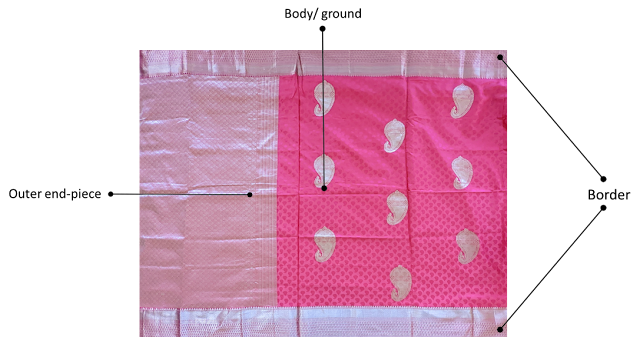
Figure 1: Parts of a saree
This seamless rectangular piece of fabric measuring between 4 to 9 meters decorated with varying pattern, colour, design and richness. The traditional saris of India exemplify the diversity and exquisite culture in India’s 28 states. With each saree, is attached a deep history, traditional knowledge, geographical details, complex and skilled making, themes, varieties, styling, and interesting facts. There are more than fifty types of sarees and dozens of different ways to drape it, which depend on the region, fabric type, length and width, and occasion.
Through this article, let’s travel through India region-by-region* to get a glimpse of the spectrum of tradition and sophistication that the sari-producing states offer. The names of saris along with their pictures, and characteristics such as fabric material, weave, print, embroidery, motifs, and varieties are given here briefly.
A. Northern Region
States: Delhi, Haryana, Himachal Pradesh, Jammu & Kashmir, Ladakh, Punjab, and Rajasthan1. Bandhani/ Lehariya of Rajasthan
- Fabric material – Silk, cotton, chiffon, georgette.
- Craft – Tie and dye or Bandhani.
- Themes – ‘Lehariya’ means waves. Brightly coloured clothes are printed with complex wave patterns.

Figure 2: Lehariya chiffon saree
2. Dabu/ Bagru/ Sanganeri prints of Rajasthan
- Fabric material – Cotton, cotton-silk blend.
- Craft – These are a mud resisting type of hand block printing using natural dyes. Sanganeri printing is done using a special technique called 'calico printing' where the outlines are first printed, then filled in and repeated in diagonal sections.
- Themes – The motifs are picked from nature and surrounding elements. The common ones in Dabu are ‘Lal titri’, ‘Dholika’, ‘Kahma’ and ‘Kantedar’. Bagru print is a mix of geometric patterns and animal/bird motifs. Floral patterns of roses, lotuses, sunflowers, lilies and marigolds are common in Sanganeri print.

Figure 3: Dabu printed cotton saree

Figure 4: Bagru printed chanderi saree

Figure 5: Sanganeri print cotton saree
3. Kota Doria of Rajasthan
- Fabric material – Cotton, silk, cotton-silk blend.
- Craft – Hand-woven fabric with fine open weave.
- Themes – The chequered weave forms tiny squares called ‘Khats’. The range includes basic, block printed, embroidered and zari. The popular motifs used are mango, flowers with petals and leaves, checks, coin, leaf and many geometrical motifs.
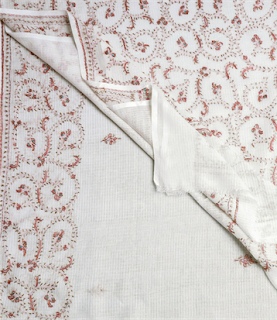
Figure 6: Embroidered kota doria saree
4. Kulluvi Pattu of Himachal Pradesh (similar is also worn in Uttarakhand)
- Fabric material – Wool.
- Craft – Hand-woven.
- Themes – Bright colours and unique patterns that are inspired from the local fauna and flora.
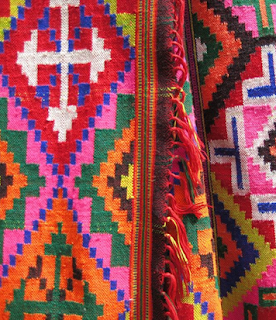
Figure 7: Kulluvi pattu design
5. Pashmina of Jammu & Kashmir
- Fabric material – Silk, wool.
- Craft – Rich and intricate pattern weaving.
- Themes – The iconic patterns include cluster of flowers, striped, chain, paisley design. It is believed to be one of the finest art forms.
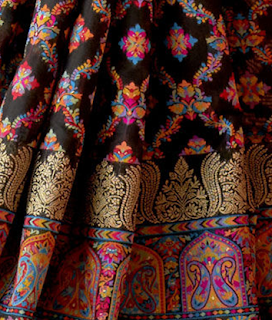
Figure 8: Pashmina weaving work saree
6. Phulkari of Punjab
- Fabric material – Cotton, silk.
- Craft – Embroidery.
- Themes – ‘Phulkari’ translates into ‘flower work’. Birds, animals, floral and leaf motifs are embroidered with horizontal, vertical, and diagonal stitches.

Figure 9: Phulkari saree
7. Pichwai painting of Rajasthan
- Fabric material – Cotton, cotton-silk blend.
- Craft – Hand-painting using pigment.
- Themes – The Pichwai paintings portray a variety of stories, including the life of Lord Krishna, Shrinathji (an incarnation of Lord Krishna), Vallabhacharya's family history, cows, lotuses and many other beautiful patterns from nature.

Figure 10: Pichwai painted saree
8. Sozni of Jammu & Kashmir
- Fabric material – Silk, wool.
- Craft – Embroidery.
- Themes – Intricate embroidery consisting floral, paisleys, and abstract geometrical motifs. Its intricacy can vary from 5 stitches per cm to 500 stiches per cm.

Figure 11: Sozni embroidery saree
B. Central Region
States fall under central central region of India: Chhattisgarh, Madhya Pradesh, Uttar Pradesh, Uttarakhand.9. Bagh of Madhya Pradesh
- Fabric material – Cotton, silk.
- Craft – Block printing and use of vegetable dyes.
- Themes – The motifs are geometrical and floral compositions in red and black colour predominantly.

Figure 12: Bagh print on Chanderi saree
10. Baiga of Chhattisgarh
- Fabric material – Cotton
- Craft – Hand-woven by Baiga tribe
- Themes – The common patterns woven are Khappa, checks, and stripes.

Figure 13: Check weave baiga cotton saree

Figure 14: Khappa weave baiga saree

Figure 15: Striped weave baiga saree
11. Banarasi of Uttar Pradesh
- Fabric material – Dupion silk, Ghicha (Tussar) silk, Monga silk, Linen, Shattir, Kora Organza, Khaddi Georgette
- Craft – Hand-woven or powerloom, giving embroidery-like appearance.
- Themes – Gold and silver brocade or zari with Mughal inspired floral, trellis, or jaali (lattice) designs. The varieties are brocade, Jamdani, Jangla, Jam war Tanchoi, Tissue, Cut work, Butidar.

Figure 16: Butidar Banarasi saree
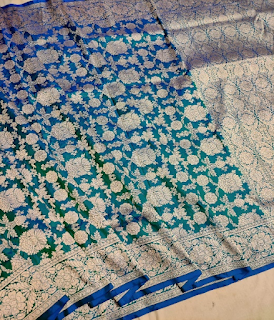
Figure 17: Floral patterned silk Jangla banarasi saree
12. Chanderi of Madhya Pradesh
- Fabric material – Silk, cotton, silk-cotton blend.
- Craft – Hand-woven fabric known for its sheer texture, light weight and a glossy transparency.
- Themes – Woven designs include traditional coin, floral art, peacocks and geometric shapes, with golden border and small booties all over.
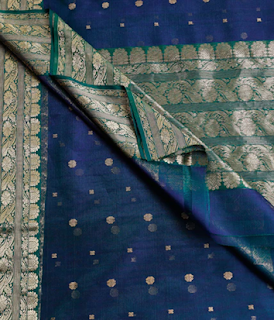
13. Chikankari of Uttar Pradesh
- Fabric material – Cotton, Semi Georgette, Pure Georgette, Crepe, Chiffon, Silk
- Craft – Chikan embroidery. There are 32 types of stitches, broadly classified into flat stitch, embossed stitch, raised stitch and open trellis.
- Themes – Finely detailed, dense floral patterns with knots, pulled network and other textural elements. Embellishments like Mukaish (a dotted pattern in silver or gold metal), Kamdani (metal wire), Badla (flat metallic thread), Sequin, bead and mirror work are also used.

Figure 19: Chikankari on georgette
14. Kosa of Chhattisgarh
- Fabric material – Kosa silk (a variety of Tussar silk)
- Craft – Hand-woven. The making of kosa silk yarn is a meticulous and complex process.
- Themes – The fabric is known for its dull golden brownish look. The finished fabric is coloured with natural dyes.

Figure 20: Kosa silk saree
15. Lodhi Lugda of Chhattisgarh
- Fabric material – Cotton.
- Craft – Hand-woven
- Themes – Plain sarees with geometric patterned borders and palloo.
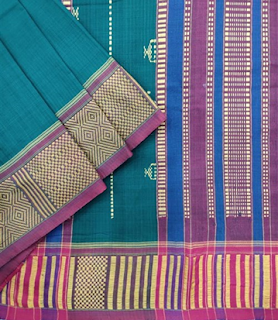
Figure 21: Lodhi mae lugda saree
16. Maheshwari of Madhya Pradesh
- Fabric material – Cotton, silk, cotton-silk blend
- Craft – Hand-woven. A genuine Maheshwari saree has the trademark reversible border, locally known as 'Bugdi'.
- Themes – The sarees fall under 5 broad categories. The Baingani Chandrakala and Chandrakala are plain ones, while the Beli, Chandratara, and Parbi come with stripes or checks. The patterns incorporated in the weaving are brick-like design, diamond shape, combination of waves and valleys, and many more.
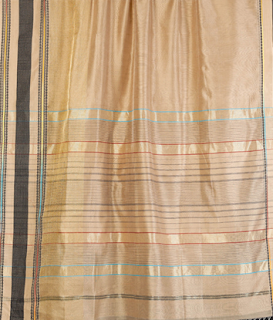
Figure 22: Maheshwari silk saree
C. Western Region
States: Gujarat, Maharashtra17. Aari stitch of Gujarat
- Fabric material – Cotton, wool
- Craft – It is a continuous fine chain stitch embroidery. The embroidery is done with an ari i.e. a needle with a hook.
- Themes – The motifs of Aari work are derived from nature and include leaves, vines, flowers, trees, birds and animals.

Figure 23: Gujarati aari work saree
18. Ajrakh print of Gujarat
- Fabric material – Cotton, silk, cotton-silk blends, viscose.
- Craft – Block-printing on both sides by resist printing method. All the printing ingredients are natural.
- Themes – The prints include bold geometric repeats, in combinations of centre field and border designs. Traditionally, these symmetrical patterns are printed and dyed in natural red and black, with the white cloth resisted on a dark indigo blue background. The names of some of these motifs are Amri Mohar (mango blossom), Surajmukhi (sunflowers), Kakkar (fluffy clouds) or Minkudi (traditional symmetrical pattern).

Figure 24: Ajrakh printed cotton saree
19. Applique work of Gujarat
- Fabric material – Cotton, silk, blends.
- Craft – Colourful and carefully stitched patchwork of various patterns.
- Themes – Geometric, floral and animal motifs are commonly employed.
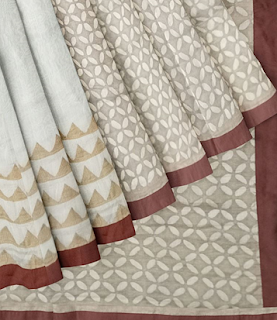
Figure 25: Applique handstitched cotton silk saree
20. Ashavali of Gujarat
- Fabric material – Silk.
- Craft – Brocade weaving.
- Themes – The weaves include motifs of birds singing, animals dancing and flowers blooming. Ashavali sarees are distinguished by the enamelled look of the border.
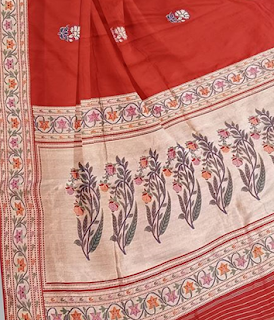
Figure 26: Brocade handwoven ashavali saree
21. Bandhani/ Bandhej and Shibori of Gujarat
- Fabric material – Loosely woven silk, georgette, cotton (malmal).
- Craft – It is the art of tie-dye patterns. It is a resist dyeing process where the fabric is pinched and tied with thread before it is dyed.
- Themes – A collection of dots are combined to form different shapes like paisley, flower, lotus, tiger, elephant, peacock, sparrow, parrot, circles, swastika, dates, grape, female figure carrying water, vines, and more. The difference between Bandhani and Shibori is in the colours, where Bandhani has vibrant hues and Shibori has subtle shades.

Figure 27: Bandhani cotton saree
.png)
Figure 28: Bandhani Gajji silk saree (Gharchola saree)

Figure 29: Shibori mul cotton saree

Figure 30: Kala cotton saree

Figure 31: Himroo saree

Figure 32: Paithani saree
Depending on the pattern of weaving there are two types of Patola sarees:

Figure 33: Patola silk saree

Figure 34: Rogan printing

Figure 35: Soof embroidered saree
Read the Part-II of this article.
References:
https://www.nationalgeographic.com/travel/article/the-story-of-the-sari-in-india
*Regions are as per- https://www.mapsofindia.com/zonal/
Image sources:

Figure 29: Shibori mul cotton saree
22. Bhujodi kala cotton of Gujarat
- Fabric material – Kata cotton. It is an organic cotton that is indigenous to the Kutch region and is purely a rain fed crop.
- Craft – Hand-woven and natural dyed. The Kala Cotton Initiative encourages sustainable cotton textile production in harmony with local ecology.
- Themes – Art of Kutch extra weft.

Figure 30: Kala cotton saree
23. Himroo of Maharashtra
- Fabric material – Silk and cotton blend.
- Craft – Hand-woven fabric having a light and luxurious satin base.
- Themes – Himroo uses Persian floral designs and paisley motifs.

Figure 31: Himroo saree
24. Paithani of Maharashtra
- Fabric material – Silk, silk blends.
- Craft – Hand-woven brocade
- Themes – Traditionally the borders are an oblique square pattern (called narali as they resemble coconuts). The palloo has large motifs of paisley, peacock, floral, mango, lotus. The saree can be classified under three criteria:
- Motifs- bangadimor, munia brocade, lotus brocade
- Weaving- kadiyal border, ekdhoti
- Colours- kalichandrakala, raghu, shirodak

Figure 32: Paithani saree
25. Patola of Gujarat
- Fabric material – Silk.
- Craft – A double Ikat hand-woven sari. Resist dyeing on warp and weft is done using natural colours.
- Themes – Parrots, flowers, elephants, dancing figures, geometric designs, floral basket, paan leaf or peepal tree leaf are the common motifs.
Depending on the pattern of weaving there are two types of Patola sarees:
- Rajkot Patola -single Ikat and vertically resist dyed
- Patan Patola-double Ikat pattern and horizontally resist dyed

Figure 33: Patola silk saree
26. Rogan print of Gujarat
- Fabric material – Cotton.
- Craft – Direct printing by the application of thickened castor oil, which gives the print an elevated appearance.
- Themes – The designs of Rogan printing are largely inspired by the Persian motifs. Geometric patterns and floral motifs are commonly used.

Figure 34: Rogan printing
27. Soof embroidery of Gujarat
- Fabric material – Cotton, linen.
- Craft – Hand embroidery is done on the reverse side of the cloth, and the motifs are displayed when turned over. In this embroidery, there is no need of drawing, printing, outline by craftswomen as they do it by careful counting of the warp and weft.
- Themes – Most of the embroidery is done in geometrical patterns, especially based on triangles.

Figure 35: Soof embroidered saree
Read the Part-II of this article.
References:
https://www.nationalgeographic.com/travel/article/the-story-of-the-sari-in-india
*Regions are as per- https://www.mapsofindia.com/zonal/
Image sources:
- https://balaramsaha.com/
- https://bunavat.com/
- https://www.itokri.com/
- https://www.nalli.com/
- https://www.omnah.in/
